1993 PONTIAC GRAND-AM stop start
[x] Cancel search: stop startPage 97 of 306
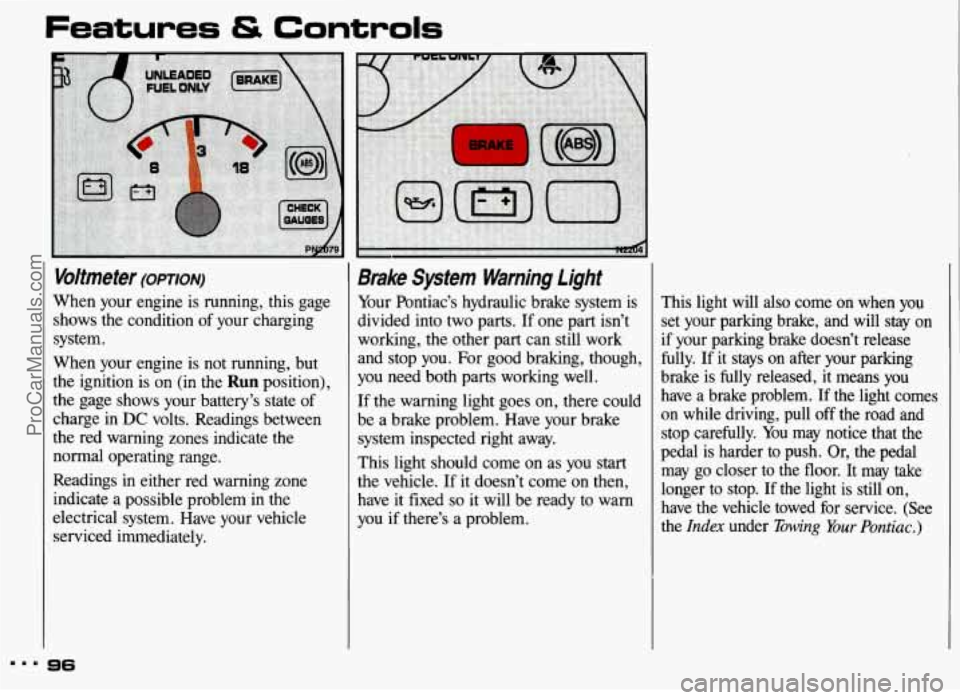
Features & Controls
Voltmeter (omoN)
When your engine is running, this gage
shows the condition of your charging
system.
When your engine is not running, but
the ignition is on (in the
Run position),
the gage shows your battery’s state of
charge in
DC volts. Readings between
the red warning zones indicate the
normal operating range.
Readings in either red warning zone
indicate a possible problem in the
electrical system. Have your vehicle
serviced immediately.
Brake System Warning Light
Your Pontiac’s hydraulic brake system is
divided into two parts. If one part isn’t
working, the other part can still work
and stop you. For good braking, though,
you need both parts working well.
If the warning light goes on, there could
be a brake problem. Have your brake
system inspected right away.
This light should come on as you start
the vehicle. If it doesn’t come
on then,
have it fixed
so it will be ready to warn
you if there’s a problem, This
light will
also come on when you
set your parking brake, and will stay on if your parking brake doesn’t release
fully. If it stays on after your parking
brake is
fully released, it means you
have a brake problem.
If the light comes
on while driving, pull off the road and
stop carefully. You may notice that the
pedal is harder to push. Or, the pedal
may
go closer to the floor. It may take
longer to stop. If the light is still on,
have the vehicle towed for service. (See
the
Index under Bwing Your Pontiac.)
m.. 96
ProCarManuals.com
Page 98 of 306

I CAUTION Anti-lock Brake Sptetn Warning
Light A Your brake system may not be
working properly if the brake
warning light is on. Driving with
the brake warning light on can lead
to
an accident. If the light is still
on after you’ve pulled off the road
and stopped carefully, have the
vehicle towed for service. Vith
anti-lock, this light will
go on
when you start your engine and may stay
on for two seconds or so. That’s normal.
If the light doesn’t come on, have it
fixed so it will be ready to warn you if
there is a problem.
If the light
stays on or comes on when
you’re driving, stop
as soon as possible
and turn the key off. Then start the
engine to reset the system.
If the light
still
stays on, or comes on again while
you’re driving, your Pontiac needs
service. Unless the regular brake system
warning light
is also on, you will still
have brakes, but not anti-lock brakes.
If
the regular brake system warning light is
also on, see Brake System Warning Light
earlier in this part.
If the anti-lock brake system warning
light ever flashes, your anti-lock brake
system
is still working but needs service
as soon as possible.
ProCarManuals.com
Page 116 of 306

RCL (Recall): Press this button once to
see which track is playing. Press again
within five seconds to see how long
your selection has been playing. The
track number
also will be displayed
when the volume is changed or a new
track
starts to play.
COMP (Compression): Pressing this
button makes
soft and loud passages
more equal in volume. Press again to
resume normal play.
RDM (Random): Press to play tracks in
random, rather than sequential, order.
Press the button again to play the tracks sequentially.
REV (Reverse): Press and hold to
rapidly reverse the disc. Release to
resume playing.
FWD (Fast Forward): Press and hold
to rapidly advance the disc. Release to
resume playing.
PREV (Previous): Press to play a track
again.
If you keep pressing the PREV
button, the disc will keep backing up to
previous tracks.
NEXT Press to advance to the next
track.
If you keep pressing the NEXT
button, the disc will keep advancing to
other tracks.
When Finished with the Compact
Disc Player:
If you press PWR or turn off the
ignition, the disc
will stay in the player
and start again when you
turn on the
ignition
or the PWR button. The disc
will begin playing at the point where it
had been stopped.
ST-PL (Stop-Play): Press to stop the
disc player; the radio will play. Press again to play the disc (the player will
start playing the disc where it had
stopped earlier).
EJCT (Eject): Press to eject the disc;
the radio will play. You can also eject
the disc with the radio or ignition
off.
115
ProCarManuals.com
Page 127 of 306
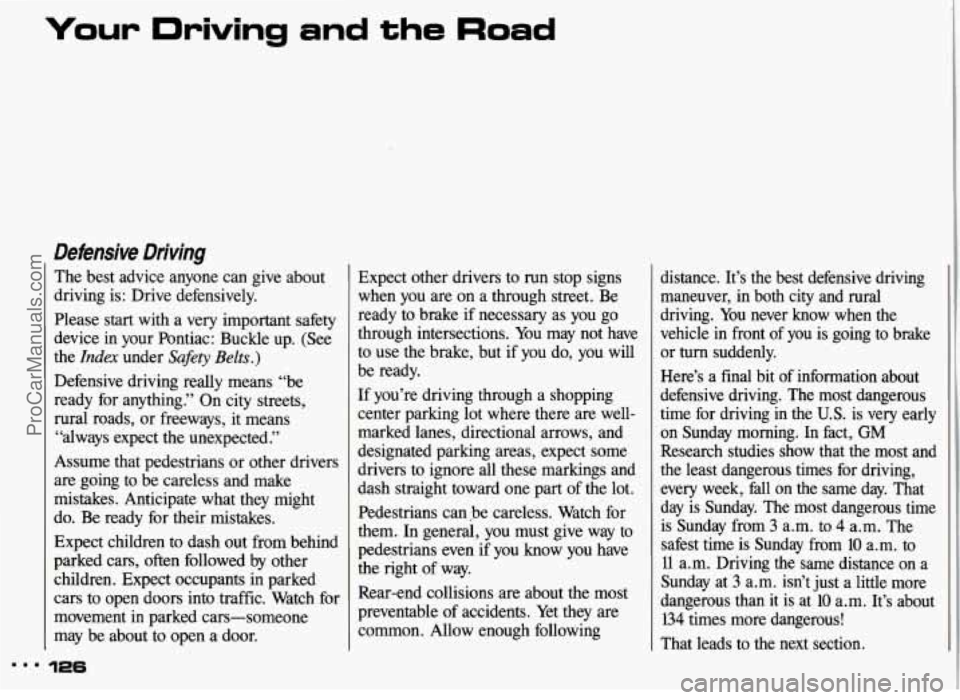
Defensive Driving
The best advice anyone can give about
driving is: Drive defensively.
Please start with a very important safety
device in your Pontiac: Buckle up. (See
the
Index under Safety Belts.)
Defensive driving really means “be
ready for anything.” On city streets,
rural roads, or freeways, it means
“always expect the unexpected
.”
Assume that pedestrians or other drivers
are going to be careless and make
mistakes. Anticipate what they might
do. Be ready for their mistakes.
Expect children to dash out from behind
parked cars, often followed
by other
children. Expect occupants in parked
cars to open doors into traffic. Watch for
movement in parked cars-someone
may be about to open a door.
126
Expect other drivers to run stop signs
when you are on a through street. Be
ready to brake if necessary as you go
through intersections. You may not have
to use the brake, but if you do, you will
be ready.
If you’re driving through a shopping
center parking lot where there are well-
marked lanes, directional arrows, and
designated parking areas, expect some
drivers to ignore all these markings and
dash straight toward one part of the lot.
Pedestrians canbe careless. Watch for
them.
In general, you must give way to
pedestrians even if you know you have
the right of way.
Rear-end collisions are about the most
preventable of accidents. Yet they are
common. Allow enough following distance. It’s the best defensive driving
maneuver, in both city and rural
driving. You never know when the
vehicle in front
of you is going to brake
or
turn suddenly.
Here’s a final bit of information about
defensive driving. The most dangerous
time for driving in the
U.S. is very early
on Sunday morning. In fact, GM
Research studies show that the most and
the least dangerous times for driving,
every week, fall on the same day. That
day is Sunday. The most dangerous time is Sunday from
3 a.m. to 4 a.m. The
safest time is Sunday from
10 a.m. to
11 a.m. Driving the same distance on a
Sunday at
3 a.m. isn’t just a little more
dangerous than it is at
10 a.m. It’s about
134 times more dangerous!
That leads to the next section.
ProCarManuals.com
Page 132 of 306
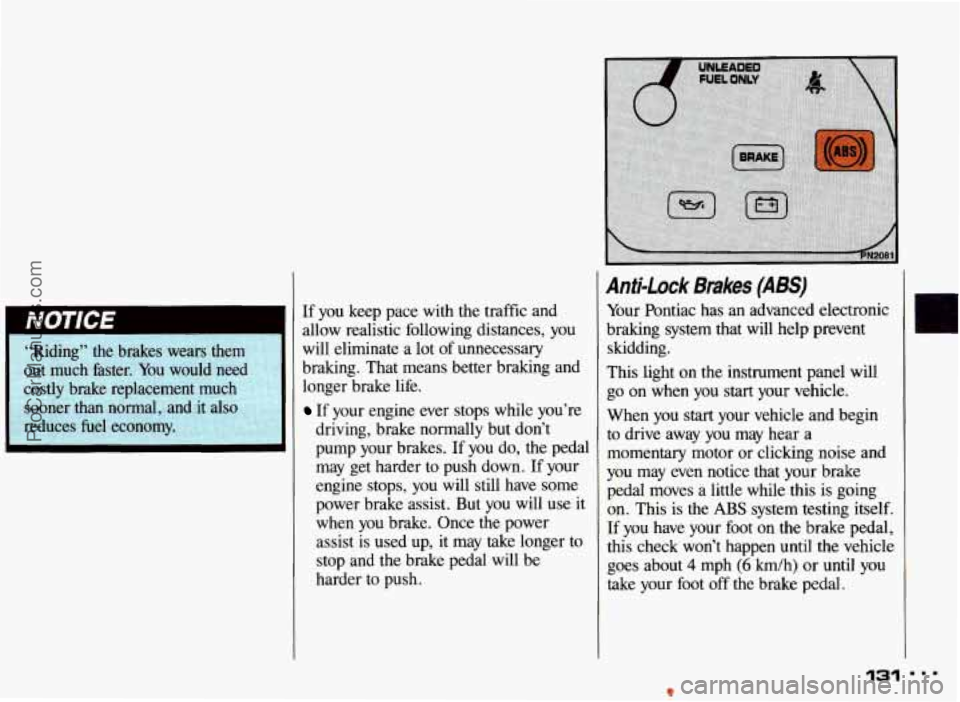
“Riding” the brakes wears them
out much faster. You would need
costly brake replacement
much
sooner than normal, and it also reduces fuel economy. If you keep pace with the traffic and
allow realistic following distances,
you
will eliminate a lot of unnecessary
braking. That means better braking and
longer brake life. If your engine ever stops while you’re
driving, brake normally but don’t
pump your brakes. If you do, the pedal
may get harder to push down. If your
engine stops, you will still have some
power brake assist. But
you will use it
when you brake. Once the power
assist is used up, it may take longer
to
stop and the brake pedal will be
harder to push.
Anti-Lock Bmkes (ABS)
Your Pontiac has an advanced electronic
braking system that will help prevent
skidding.
This light on the instrument panel will
go on when you start your vehicle.
When you
start your vehicle and begin
to drive away you may hear a
momentary motor or clicking noise
and
you may even notice that your brake
pedal moves a little while this is going
on. This is the ABS system testing itself.
If you have your foot on the brake
pedal,
this check won’t happen until the vehicle
goes about
4 mph (6 km/h) or until you
take your foot off the brake pedal.
131
ProCarManuals.com
Page 140 of 306

So here are some tips for passing:
“Drive ahead.” Look down the road,
to the sides, and to crossroads for situations that might affect your
passing patterns. If you have any doubt
whatsoever about making a successful
pass, wait for a better time.
markings, and lines.
If you can see a
sign up ahead that might indicate a
turn or an intersection, delay your
pass.
A broken center line usually
indicates it’s all right to pass (providing
the road ahead is clear). Never cross
a
solid line on your side of the lane or a
double solid line, even if the road
seems empty of approaching traffic.
0 Watch for traffic signs, pavement
If you suspect that the driver of the
vehicle you want to pass isn’t aware of
your presence, tap the horn a couple
of times before passing. Or, you can
use flash-to-pass. See the
Index under
Flash-to-Pass.
Do not get too close to the vehicle you
want to pass while you’re awaiting
an
opportunity. For one thing, following
too closely reduces. your area of
vision, especially if you’re following a
larger vehicle.
Also, you won’t have
adequate space if the vehicle ahead
suddenly slows or stops. Keep back a
reasonable distance.
When it looks like a chance to pass is
coming up,
start to accelerate but stay
in the right lane and don’t get too
close. Time your move
so you will be
increasing speed
as the time comes to
move into the other lane.
If the way is
clear to pass, you will have
a “running
start” that more than makes up for the
distance you would lose by dropping
back. And if something happens
to
cause you to cancel your pass, you
need only slow down and drop back
again and wait for another opportunity.
slow vehicle, wait your
turn. But take
care that someone isn’t trying to pass
you as you pull out
to pass the slow
vehicle. Remember to glance over your
shoulder and check the blind spot.
If other cars are lined up to pass a
ProCarManuals.com
Page 142 of 306
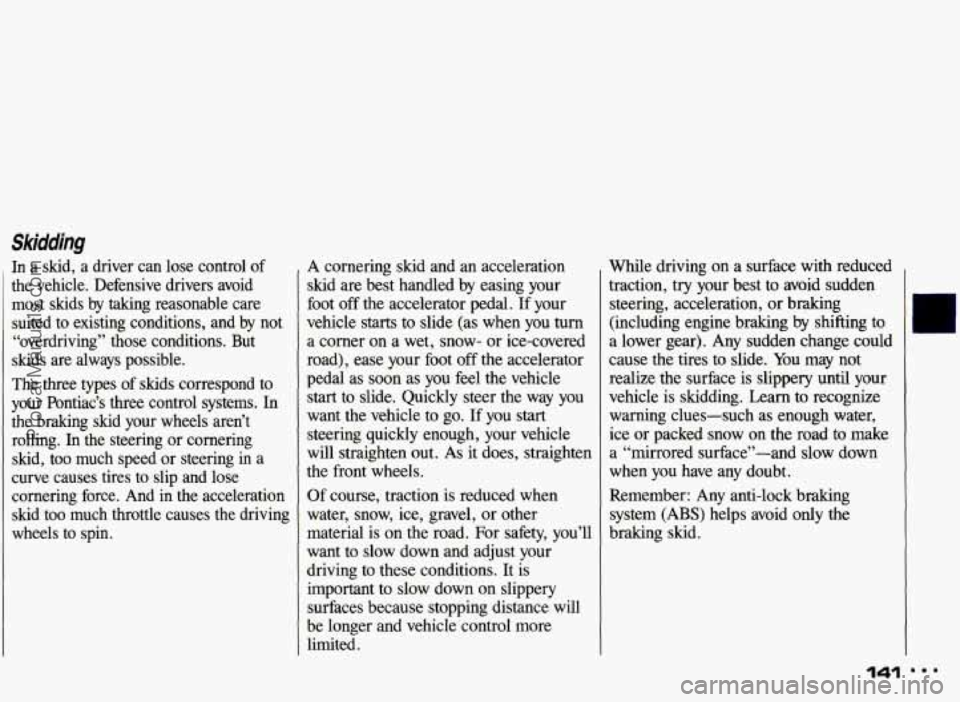
Skidding
In a skid, a driver can lose control of
the vehicle. Defensive drivers avoid
most skids by taking reasonable care
suited to existing conditions, and by not
“overdriving” those conditions. But
skids are always possible.
The three types of skids correspond to
your Pontiac’s three control systems.
In
the braking skid your wheels aren’t
rolling.
In the steering or cornering
skid, too much speed or steering in a
curve causes tires to slip and lose cornering force. And in the acceleration
skid too much throttle causes the driving
wheels to spin. A
cornering skid and an acceleration
skid are best handled by easing your
foot
off the accelerator pedal. If your
vehicle starts to slide (as when you turn
a corner on a wet, snow- or ice-covered
road), ease your foot off the accelerator
pedal as soon as you feel the vehicle
start to slide. Quickly steer the way you
want the vehicle to go.
If you start
steering quickly enough, your vehicle
will straighten out. As it does, straighten
the front wheels.
Of course, traction is reduced when
water, snow, ice, gravel, or other
material is on the road. For safety, you’ll
want to slow down and adjust your
driving to these conditions. It is
important to slow down on slippery surfaces because stopping distance will
be longer and vehicle control more
limited. While driving on
a surface with reduced
traction, try your best to avoid sudden
steering, acceleration, or braking
(including engine braking by shifting to
a lower gear). Any sudden change could
cause the tires to slide.
You may not
realize the surface is slippery until your
vehicle is skidding. Learn to recognize
warning clues-such as enough water,
ice or packed snow
on the road to make
a “mirrored surface”-and slow down
when you have any doubt.
Remember: Any anti-lock braking
system
(ABS) helps avoid only the
braking skid.
141
ProCarManuals.com
Page 145 of 306
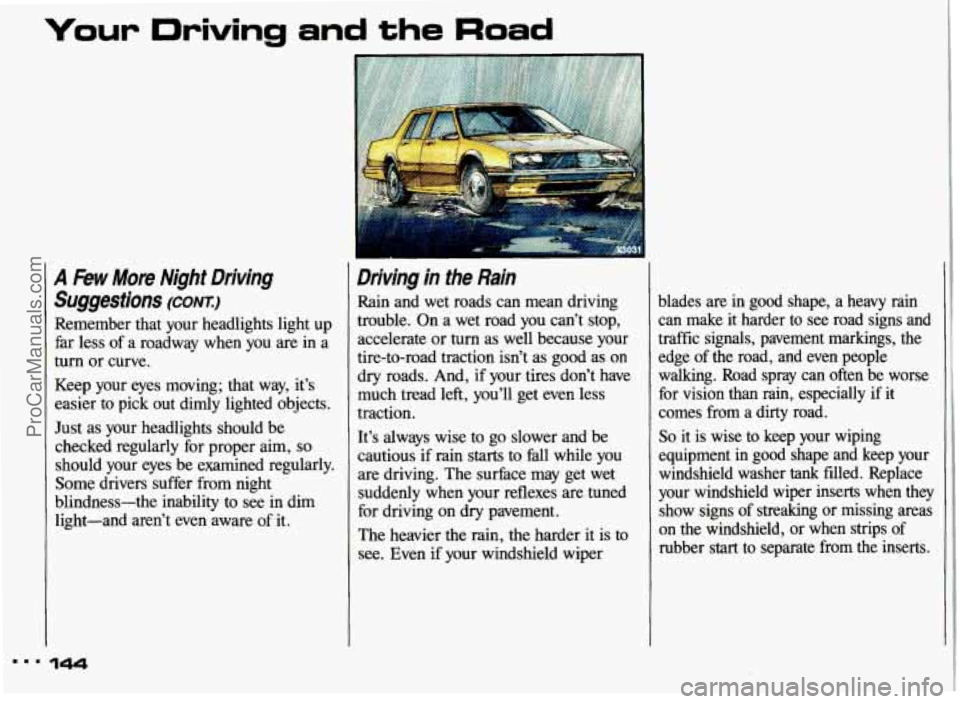
Your Driving and the Road
A &w More Night Driving
Suggestions
(CONTJ
Remember that your headlights light up
far
less of a roadway when you are in a
turn or curve.
Keep your eyes moving; that way,
it’s
easier to pick out dimly lighted objects.
Just as your headlights should be
checked regularly for proper aim,
so
should your eyes be examined regularly.
Some drivers suffer from night
blindness-the inability to see
in dim
light-and aren’t even aware
of it.
144
Driving in the Rain
Rain and wet roads can mean driving
trouble. On a wet road you can’t stop,
accelerate or
turn as well because your
tire-to-road traction isn’t as good
as on
dry roads.
And, if your tires don’t have
much tread left, you’ll get even less
traction.
It’s always wise to go slower and be
cautious
if rain starts to fall while you
are driving. The surface may get wet
suddenly when your reflexes are tuned
for driving on
dry pavement.
The heavier the
rain, the harder it is to
see. Even if your windshield wiper blades are in good shape, a heavy rain
can make it harder to see road signs and
traffic signals, pavement markings, the edge of the road, and even people
walking. Road spray can often be worse for vision than rain, especially
if it
comes from
a dirty road.
So it is wise to keep your wiping
equipment in
good shape and keep your
windshield washer
tank fdled. Replace
your windshield wiper inserts when they show signs of streaking or missing areas
on the windshield, or when strips of
rubber
start to separate from the inserts.
ProCarManuals.com